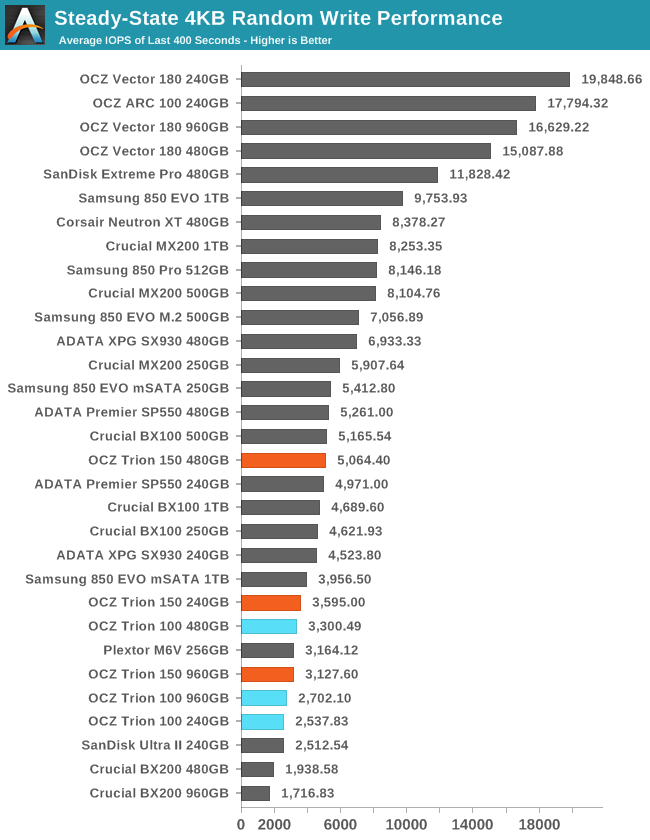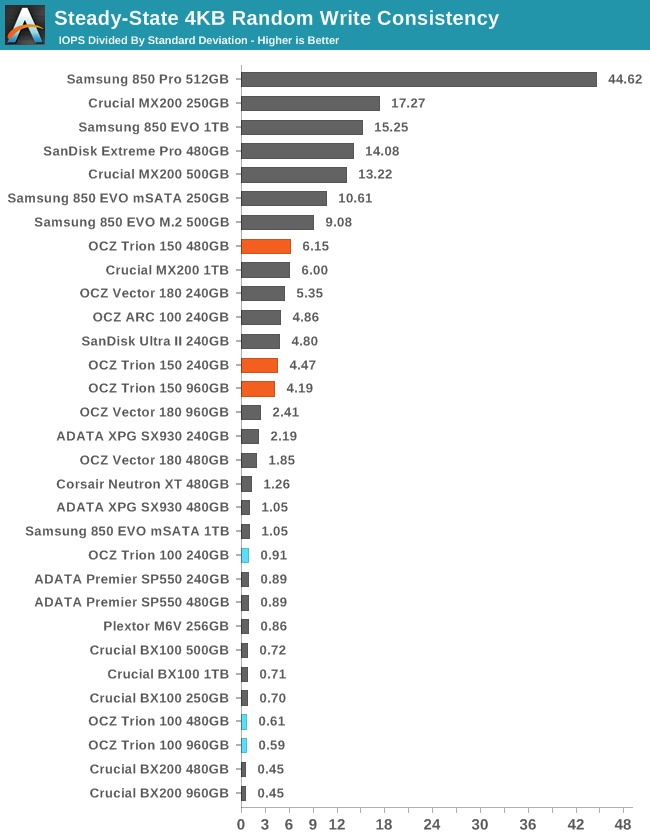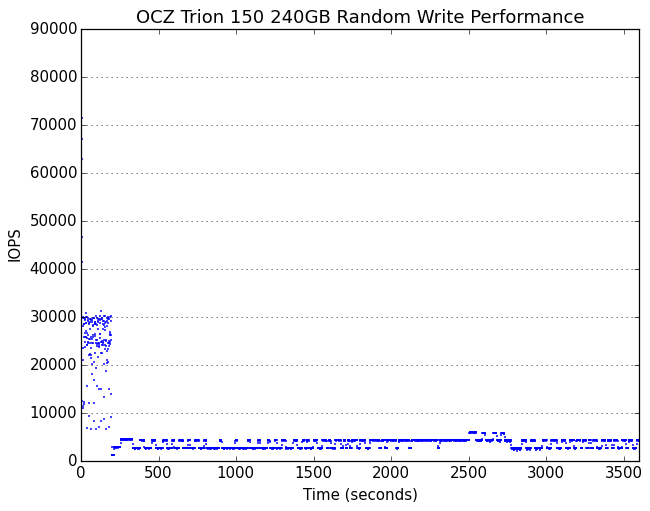The OCZ Trion 150 SSD Review
by Billy Tallis on April 1, 2016 8:00 AM ESTPerformance Consistency
Our performance consistency test explores the extent to which a drive can reliably sustain performance during a long-duration random write test. Specifications for consumer drives typically list peak performance numbers only attainable in ideal conditions. The performance in a worst-case scenario can be drastically different as over the course of a long test drives can run out of spare area, have to start performing garbage collection, and sometimes even reach power or thermal limits.
In addition to an overall decline in performance, a long test can show patterns in how performance varies on shorter timescales. Some drives will exhibit very little variance in performance from second to second, while others will show massive drops in performance during each garbage collection cycle but otherwise maintain good performance, and others show constantly wide variance. If a drive periodically slows to hard drive levels of performance, it may feel slow to use even if its overall average performance is very high.
To maximally stress the drive's controller and force it to perform garbage collection and wear leveling, this test conducts 4kB random writes with a queue depth of 32. The drive is filled before the start of the test, and the test duration is one hour. Any spare area will be exhausted early in the test and by the end of the hour even the largest drives with the most overprovisioning will have reached a steady state. We use the last 400 seconds of the test to score the drive both on steady-state average writes per second and on its performance divided by the standard deviation.

The Trion 150 substantially improves steady-state performance over its predecessor. The middle 480GB capacity is once again the best-performing size by a wide margin.

The Trion 150's consistency score has climbed out of the gutter—aided somewhat by the improved average performance, but there's clearly been a major change in behavior for the drive firmware that reduces the variability of write performance. The Trion 150 scores much better than any other budget drive.
 |
|||||||||
| Default | |||||||||
| 25% Over-Provisioning | |||||||||
After a very short initial burst of high performance due to SLC write caching, the Trion 150 settles into a pattern of decent but broadly variable performance as it burns through the remaining spare area. Once the spare area is exhausted the behavior changes completely and the drive is very steady, transitioning between a handful of discrete performance levels.
 |
|||||||||
| Default | |||||||||
| 25% Over-Provisioning | |||||||||
Looking closer at the steady-state phase, the transitions between performance states are very clear and abrupt, and there are no outliers in either direction. The performance with manual overprovisioning is substantially higher and the consistency is only slightly worse. In either case, the consistency is as good as we could ask for and a big improvement over the earlier Trion 100.










79 Comments
View All Comments
ummduh - Friday, April 1, 2016 - link
Ditto. Fool me once, shame on you. Fool me twice, not a chance.Murloc - Saturday, April 2, 2016 - link
yeah they could just kill the brand for anything SSD-related.NeonFlak - Friday, April 1, 2016 - link
The Mushkin Reactor not being included on any charts for SSD reviews must be a conspiracy, right? You guys did review it and it's in your best SSDs for 2016 list. Yet it doesn't appear to be included on the charts for any of the SSD reviews. Or am I just missing it?Billy Tallis - Friday, April 1, 2016 - link
It was reviewed with the 2014 test suite and I don't have the drive available to re-test with the current (2015) suite. The results from the Mushkin Reactor review may not be directly comparable to the current reviews, but indicate that it performs a little worse than the Crucial BX100 that has the same controller and flash.ghanz - Friday, April 1, 2016 - link
Hi Billy, will there be a future review on the Sandisk Plus which presumably uses SM2246XT & MLC NAND?It's the lowest tier in Sandisk's SSD lineup & is priced even lower than the TLC based Ultra II.
hojnikb - Friday, April 1, 2016 - link
+1 for that. Almost picked it up but went with a second hand 840pro instead.Samus - Sunday, April 3, 2016 - link
I actually had an 840 Pro that was 2 years old fail on me a few months ago. It was hell getting Samsung to warranty it. The process was awful. I've been using it lightly a few months, and I'd sell it if you want it. $90 bucks. It's a 256GB.vanilla_gorilla - Friday, April 1, 2016 - link
The people complaining about the drives performance need to consider that what's beating it cost significantly more. These are drives for low-mid range computers. And for 99% of your desktop use, if I swapped out your much more expensive (probably Samsung) SSD you'd probably never notice the difference in day to day use.Take a breath, have a little perspective, stop worrying about inconsequential (relative to the intended use) benchmarks and take a close look at the cost.
Arnulf - Friday, April 1, 2016 - link
Not really - this drive costs more and sometimes performs worse than its in-house competitor (Trion 100). The fact that it only reliably trumps BX200 is quite telling ...Tanclearas - Friday, April 1, 2016 - link
Take a look at the Mushkin Enhanced Reactor. Its results will be VERY close to the BX100. That drive outperforms (often by a large margin) the OCZ in nearly all benchmarks, and it costs the same. In fact, Newegg regularly has it on sale for $209.